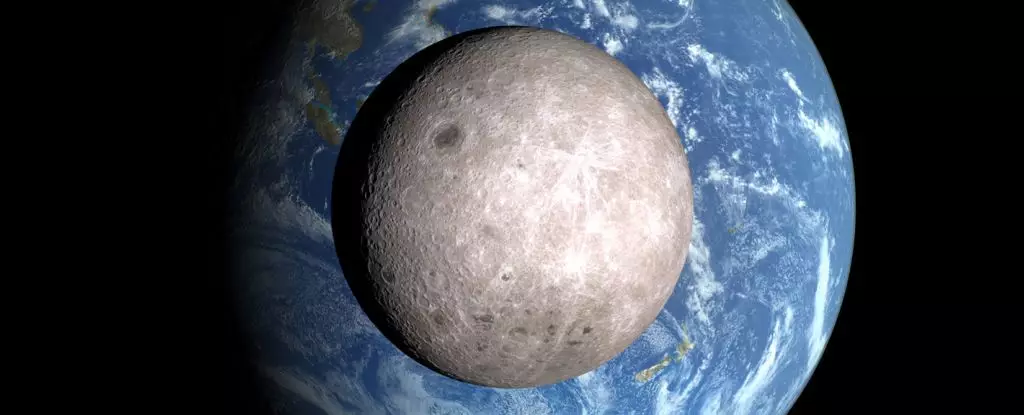The Moon, Earth’s enigmatic companion, has captivated humanity for centuries, but recent revelations about its internal structure have delivered baffling insights that challenge our understanding of celestial bodies. A recent study examining lunar materials, particularly samples from the Moon’s far side brought back by the Chinese Chang’e-6 mission, reveals a surprising discrepancy in water distribution between the Moon’s two hemispheres. This study suggests that the side facing away from Earth may be drier, a puzzling phenomenon that raises questions about the Moon’s geological history and formation.
Contrasted against the familiar lunar landscape seen from Earth, the far side of the Moon is a rugged, crater-laden expanse. On the other hand, the near side boasts vast basaltic plains—known as maria—that formed from ancient volcanic activity. These stark differences in surface composition present not just a visual contrast but an intellectual challenge for scientists attempting to reconcile the geological narratives of the Moon’s two hemispheres. The presence of water—or lack thereof—could act as a crucial factor in sewing together the fragmented story of the Moon’s origin.
Understanding Lunar Formation Theories
To grasp the implications of these findings, one must delve into the prevailing theories surrounding the Moon’s formation. Leading hypotheses posit that the Moon was formed from debris generated by a colossal impact between the early Earth and a Mars-sized celestial object named Theia, approximately 4.5 billion years ago. This cataclysmic event launched vast amounts of material into orbit, which eventually clumped together to create the Moon.
Initially, the Moon was molten, with an expansive magma ocean cooling unevenly over eons. The disparity in crust thickness between the two hemispheres is one potential reason for the near side’s abundant basaltic plains. The Earth’s gravitational influence maintained a warmer environment on the side of the Moon facing it, facilitating volcanic activity that gave rise to the maria. In turn, an assessment of the lunar mantle’s water content can shed light on how this peculiar hemispherical composition came to be.
The Role of Water in Lunar Geology
Water on the Moon is far more than a mere curiosity; it is a central player in understanding the processes that shaped its geology. The research led by Huicun He and Linxi Li indicates that the water abundance in the lunar mantle correlates with essential models of lunar formation and evolution. Their analysis emphasizes that water plays a pivotal role not only in the cooling and crystallization processes of the early lunar magma ocean but also in the subsequent volcanic activity that formed the maria.
Interestingly, the study provides a unique glimpse into the low water content of the far side, with estimates suggesting only about 1 to 1.5 micrograms of water per gram of rock. This lack of hydration, especially in the context of the South Pole-Aitken Basin—the largest impact feature on the Moon—raises the intriguing possibility that the extreme forces involved in the impact may have redistributed material, leading to the dry composition noted.
Potential Implications and Scientific Queries
While the findings present compelling evidence of the Moon’s differential water distribution, they also invite further inquiries. What if there are regions on the far side yet unexplored that possess greater water contents? The current analysis is based on limited samples, and the complexity of lunar geology suggests that there may be many hidden layers yet to uncover. The Chang’e-6 mission marks a significant stride, but it may well be just the tip of the iceberg in our quest for understanding the Moon.
Furthermore, planetary scientists are left pondering the broader implications of these findings. How do the Moon’s geologic features compare with other celestial bodies? What does this mean for the prospects of human exploration and potential colonization? Water is vital for sustaining life, and understanding its distribution on celestial bodies is closely tied to future endeavors in space exploration. The asymmetrical water distribution could influence where future lunar bases might be established, underscoring the importance of continued investigation into the Moon’s mysteries.
In the grand scheme of cosmic exploration, the Moon’s water story goes beyond mere scientific interest; it is representative of humanity’s enduring quest to understand its place in the universe. While significant strides have been made, the journey into the depths of lunar history has just begun. With each discovery, we peel back the layers of not only the Moon’s geological history but also our own aspirations for what lies beyond our pale, blue dot. As we venture forth into this new era of lunar exploration, the Moon stands not only as a subject of scientific inquiry but as a beacon of potential for humanity’s greater aspirations.

Leave a Reply